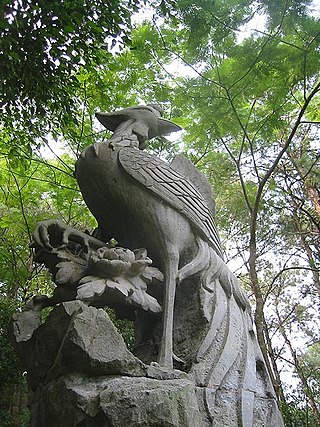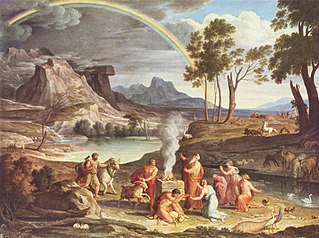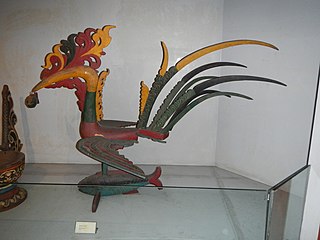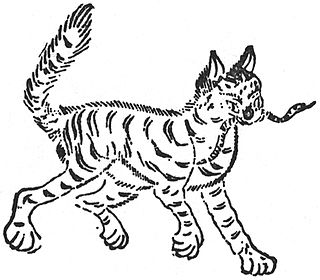Related Research Articles

A lunar eclipse is an astronomical event that occurs when the Moon moves into the Earth's shadow, causing the Moon to be darkened. Such an alignment occurs during an eclipse season, approximately every six months, during the full moon phase, when the Moon's orbital plane is closest to the plane of the Earth's orbit.

Fènghuáng are mythological birds found in Sinospheric mythology that reign over all other birds. The males were originally called fèng and the females huáng, but this distinction of gender is often no longer made and they are blurred into a single feminine entity so that the bird can be paired with the Chinese dragon, which is traditionally deemed male.

Rāhu is one of the nine major celestial bodies (navagraha) in Hindu texts and the king of meteors. It represents the ascension of the Moon in its precessional orbit around the Earth, also referred as the north lunar node, and along with Ketu, is a "shadow planet" that causes eclipses. Despite having no physical existence, Rahu has been allocated the status of the planet by ancient seers owing to its strong influence in astrology.

The rainbow has been a favorite component of mythology throughout history among many cultures around the world. Abrahamic traditions see it as a covenant with God to preserve the world from a second flood. Whether as a bridge to the heavens, messenger, archer's bow, or serpent, the rainbow has served as a symbol for millennia. There are myriad beliefs in a complex diversity with several repeated themes.

Philippine mythology is rooted in the many indigenous Philippine folk religions. Philippine mythology exhibits influence from Indonesian, Hindu, Muslim, Shinto, Buddhist, and Christian traditions.

The Sarimanok, also known as papanok in its feminine form, is a legendary bird of the Maranao people, who originate from Mindanao, an island in the Philippines, and part of Philippine mythology. It comes from the words sari and manok. Sari means "assorted" or "various", while manok originally meant "bird" as evidenced by early Spanish colonial sources, but came to mean only "chicken", which is how it is understood today.
Pedro Penduko is a Filipino fictional comic book character created by National Artist for Literature Francisco V. Coching. The character, who is styled as a folk hero, debuted in the magazine Liwayway in 1954.

The Bakunawa is a serpent-like dragon in Philippine mythology. It is believed to be the cause of eclipses, earthquakes, rains, and wind. The movements of the Bakunawa served as a geomantic calendar system for ancient Filipinos and were part of the rituals of the babaylan priestess. It is usually depicted with a characteristic looped tail and a single horn on the nose. It was generally believed to be a sea serpent, but are also variously believed to inhabit either the sky or the underworld.

The tiangou is a legendary creature from China. The tiangou resembles a black dog or meteor, which is thought to eat the Sun or Moon during an eclipse.
Ripples is an Italian animated television series created and produced by Animabit and Rai Fiction. The first series was broadcast on Italian RAI television beginning July 8, 2007. It currently airs on RAI television, KidZone TV and TV2 (Norway), ABC Australia and Al Jazeera.
Pagan Moon is a 1932 Warner Bros. Merrie Melodies cartoon directed by Rudolf Ising. The short was released on January 31, 1932.
References
- ↑ Benedict, Laura Estelle Watson (2005). A study of Bagobo ceremonial, magic and myth /.
- ↑ "Minokawa (The Origin of the Eclipse)" . Retrieved 2008-09-13.
- ↑ "THE DEMONS OF PHILIPPINE LOWER MYTHOLOGY". Archived from the original on 2009-10-24. Retrieved 2008-09-13.
- ↑ "Story of the Eclipse" . Retrieved 2008-09-13.